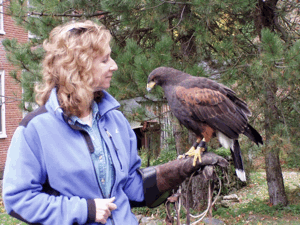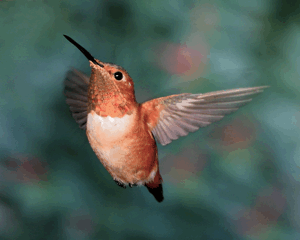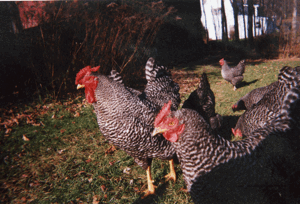Humans and Birds: A New Pairing
Air Date: Week of May 28, 2010

Sy Montogomery learning falconery. (Photo courtesy of: Selinda Chiquoine)
We see birds everyday: flying overhead, eating food scraps in cities, and singing perched in tree branches. But most of us have little relationship with these omnipresent animals. Host Jeff Young talks with naturalist Sy Montgomery about her new book that attempts to change the way that we think about birds. Her book is called, “Birdology: Adventures with a Pack of Hens, a Peck of Pigeons, Cantankerous Crows, Fierce Falcons, Hip Hop Parrots, Baby Hummingbirds, and One Murderously Big Living Dinosaur.”
Transcript
YOUNG: Author and Living on Earth contributor Sy Montgomery wants to challenge the way we relate to the other species we live with here on Earth, especially some of the ones we most take for granted—birds.
Her new book “Birdology” is an ambitious study of the avian world, and its subtitle gives a hint of just how wide-ranging the book is: it’s “Adventures with a pack of hens, a peck of pigeons, cantankerous crows, fierce falcons, hip hop parrots, baby hummingbirds, and one murderously big living dinosaur.” Sy Montgomery, welcome back to Living on Earth.
MONTGOMERY: Thanks for having me.
YOUNG: You went pretty far a field in your research—all the way to the other side of the planet in search of what you call the “dinosaur bird,” the cassowary.

The dinosaur bird: the Cassowary. (Photo courtesy of Jim Rowan)
MONTGOMERY: Yes, the cassowary! This is a bird who weighs 150 pounds, he’s got a tall helmet of bone on his head, he’s got these amazing feet equipped with slashing toenails—they look more like dinosaurs than many dinosaurs did. And so the chance to see one of these in the wild was really worth a great deal of effort. [Laughs]
YOUNG: And you kept trying and trying, going to this place and that. They’re fairly elusive. Finally you had your moment.
MONTGOMERY: That’s right. That’s right. It was actually the last day I was in Australia, and I thought, ‘Oh, no, I’m going to have to go home and I will have heard it, but never seen it.’
And as I sat there on a bench, just waiting, that was when the bird slipped out of the forest, stepping as if through a crack in time, and this man-tall, 150-pound bird steps out of the forest right in front of me. So close that I could see his orange eyes, and even the eyelashes fringing it. I could see the red waddles swaying on the blue neck. I could see how the cask, the helmet of bone, curved slightly to one side. I could see the long, slashing toenail on the foot.
And of course, you know, the bird had to have seen me—here I am 125 pounds with yellow hair sitting right there, but he never looked at me. It was like I didn’t exist. It was as if I had traveled back into time, and there weren’t any people. I finally had a wish I’d treasured since I was a little kid playing with my plastic dinosaurs. I had a dinosaur right in front of me.
YOUNG: The cassowary’s call—you describe it as something that you feel in your chest almost more than you hear?
MONTGOMERY: Yes. People who have heard cassowary calls in the wild often think they’re in an earthquake, because it’s this deep, thunderous, resonate call. Did you see “Jurassic Park”?
YOUNG: Mm hmm.
MONTGOMERY: There’s a point in “Jurassic Park” where the dinosaurs are coming—
YOUNG: You see the water vibrating in the cup and things like that?
MONTGOMERY: Exactly, that’s what this sounds like. And in fact it probably is very similar to the kinds of calls that dinosaurs made because there are plenty of dinosaurs, particularly the ones we call the hadrosaurs, or the duck-billed dinosaurs, that had those tall, helmets of bone on the head. And it’s this deep call that travels a long way in the wet rainforest.
YOUNG: Well, it’s a fascinating glimpse into that bird and also the community that has embraced that bird. Everywhere you go, you find people who have these really special relationships with birds. I guess that’s part of your quest here is to better understand not just birds, but how bird and people really relate?
MONTGOMERY: Exactly. In fact, all of my books really are looking at the relationships between people and the rest of animate creation. Many of us go through our whole day interacting only with one species. And while it’s true that humans are pretty great and, you know, I married one, my whole family isn’t made up of just one species—I’ve got several species in my family, and it’s important to me to have relationships with members of other species. Otherwise, how can we feel at home on this earth?

Sy Montogomery learning falconery. (Photo courtesy of: Selinda Chiquoine)
YOUNG: You know, I really liked your chapter on falconry and birds of prey. The fierceness that you write about is so evident in these animals it’s striking—they are pure. And I really like that you strongly identified with that, so much so that you had to learn falconry.
MONTGOMERY: Yes, it’s because I love birds, of course, but falconry is venery. I always thought venery was one of the seven deadly sins, but venery is hunting. And I’m definitely not a hunter. I mean I’m a vegetarian! I won’t eat a hamburger. So—
YOUNG: You had to get over that in a hurry if you’re going to be—
MONTGOMERY: [Laughs] Oh my Gosh!
YOUNG: Wait a minute, you raise chickens, and here you are, you’re going to be feeding these hawks baby chicks, little chicks, is that right?
MONTGOMERY: Yes, and I have raised baby chicks by keeping them in my sweater all day. I mean, it was rough, but I wanted this so badly, to touch that fierceness to touch the pureness of that living in the moment, that instinctiveness, that pure wildness. I really wanted to go there.

An Allen's Hummingbird. (Photo courtesy of J. Turner MD/VIREO)
And the only way to really go there is to become a hawk’s hunting partner because hunting is what they want. The term in falconry is called “yarak” and it names that intense desire, the desire above all else to hunt, to chase, to catch and to be a part of that is thrilling beyond measure.
YOUNG: I got the feeling at several points in the book that you felt this temptation, as we all do, to project human qualities onto animals that we identify with. But in this chapter on the hawks I got the feeling that you decided it’s best to just appreciate these animals for what they are.
MONTGOMERY: Well, you know, what we call human qualities aren’t just shared by humans unless you think we arose bonobo. Evolution tells us that we share 40 percent of our DNA with a daisy and just because we as humans can think and feel it doesn’t mean that nobody else can think and feel.
But in some case I’m certain that birds can in fact think and feel much as we do because there’s some bird that can tell us this—Parrots who talk and speak meaningfully. But in the hawks I was concentrating on an aspect of birds that isn’t necessarily shared with humans, and I’m so interested throughout this book and exploring the ways that we are both like and unlike birds. I’m fascinated by both their sameness and their otherness. And in the hawk chapter I’m very much exploring that otherness.
YOUNG: You went really far a field to do some of this work, but a lot of it was motivated by the birds right there in your backyard. You develop a relationship with your chickens I think not a lot of people who keep chickens do. They’re almost members of the family.

Dominique Chickens. (Photo courtesy of Howard Mansfield)
MONTGOMERY: Oh, they certainly are. They come in the mail as babies, and I keep them the first few weeks in my office where I write. And they grow up sitting on my shoulders, sitting in my lap. And they adopt me as an honorary chicken, so this gives me a great view into the chicken universe.
YOUNG: Raising chickens, especially now, increasingly in urban settings—it’s kind of a hot thing! Why do you think that’s taking off?
MONTGOMERY: I think it’s starts with this idea of self-sufficiency, but then something else happens that maybe people didn’t initially bargain for. And that is that they fall in love with their chickens. They realize, these are smart animals, these are not stupid automatons; each one has an individual personality; they make these lovely sounds, they’re beautiful, they’re graceful; and they know us. It’s now known from laboratory experiments that the average chicken can recognize 100 other individuals.
And they look at each other and know who you are pretty much the way we do, by looking at the face. They’re really great. And each one is extremely individualistic. Some are bold and brassy, some are shy. Some are real smart. And you can’t really spend time with chickens without realizing that everything we know about chickens—like that they’re stupid, filthy, automatons—is completely wrong. They’re so surprising; you can’t help but fall in love.
YOUNG: A chicken is a bird that has such a special relationship with people—what have you learned about how we and they affect each other?
MONTGOMERY: Well, unfortunately, most peoples’ relationship with chicken is of a culinary nature. [Laughs] And I was very surprised to learn that the humane laws that cover—and they aren’t strong enough for mammals, but they do exist for mammals who are raised for food—they do not exist for birds.
And the last place in the world that you should keep a chicken is cooped up in a place where they can’t have meaningful relationships with other chickens. That’s everything to a chicken. You hear about the pecking order—the pecking order is about order, it’s not about pecking, but it’s really important to know who you are in the flock. They’re very social creatures.
YOUNG: What do you think is the most surprising thing you’ve learned about birds in the course of researching and writing this book?
MONTGOMERY: The most unwelcome surprise was the rate at which birds are declining, and this was shock: one out of every eight bird species is in decline, worldwide. And in North America, a quarter of our birds have been declining since 1970. It’s worse on some continents: in Europe it’s nearly half the common birds that are in decline, including the famous nightingale.
I suppose it shouldn’t be all that surprising because we know exactly what’s causing the problem, it’s the usual suspects—it’s overpopulation, it’s deforestation, it’s pollution, it’s global climate change. According to Bird Life International, global climate change is the number one reason that birds are in decline around the world. So, we know why it is and we know how to fix it. And it’s my hope that we will let the birds inspire us and give us the courage to do what we know needs doing to make this world a fit place for birds and beasts.
YOUNG: Sy Montgomery, the book is Birdology – thank you so much.
MONTGOMERY: Thank you for having me back on.
Links
Living on Earth wants to hear from you!
Living on Earth
62 Calef Highway, Suite 212
Lee, NH 03861
Telephone: 617-287-4121
E-mail: comments@loe.org
Newsletter [Click here]
Donate to Living on Earth!
Living on Earth is an independent media program and relies entirely on contributions from listeners and institutions supporting public service. Please donate now to preserve an independent environmental voice.
NewsletterLiving on Earth offers a weekly delivery of the show's rundown to your mailbox. Sign up for our newsletter today!
 Sailors For The Sea: Be the change you want to sea.
Sailors For The Sea: Be the change you want to sea.
 The Grantham Foundation for the Protection of the Environment: Committed to protecting and improving the health of the global environment.
The Grantham Foundation for the Protection of the Environment: Committed to protecting and improving the health of the global environment.
 Contribute to Living on Earth and receive, as our gift to you, an archival print of one of Mark Seth Lender's extraordinary wildlife photographs. Follow the link to see Mark's current collection of photographs.
Contribute to Living on Earth and receive, as our gift to you, an archival print of one of Mark Seth Lender's extraordinary wildlife photographs. Follow the link to see Mark's current collection of photographs.
 Buy a signed copy of Mark Seth Lender's book Smeagull the Seagull & support Living on Earth
Buy a signed copy of Mark Seth Lender's book Smeagull the Seagull & support Living on Earth

